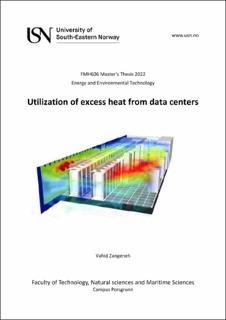| dc.description.abstract | The rapid growth of technology and digitization lead to an increase in the number of data centers around the world. Data center facilities enable an organization to collect its resources and infrastructure for data processing, storage, and communication. In the meanwhile, the advancement of IT and telecommunications play an important role in the expansion of data centers. The main input energy of data center is electric power and because of facilities in a data center which are IT equipments, a large amount of heat is generated in the data center and the main energy output from the data center is heat. This work is about the utilization of excess heat which is produced in the data center and used for district heating. Typically, the quality of temperature heat from the data center is low and a heat pump might be necessary to improve the quality of heat by increasing the temperature. This work evaluates three alternatives heat pumps to improve the quality of heat and compare them to each other and with the case without a heat pump. Then, the payback period and economic potential for all conditions are evaluated.
Aspen HYSYS is used for simulation and economic optimization of this work. The first case is without heat pumps and three alternatives with heat pumps. Cooling water temperature from the data center is 45℃ (in all conditions) and after using heat pumps the temperature increase to 60℃, 70℃, and 80℃ respectively for the district heating network while in the first case without a heat pump the water 45℃ is used for district heating network. The coefficient of performance (COP) of the heat pump for three alternatives is calculated and R-22 is used as the refrigerant in heat pumps in the simulation program, Aspen HYSYS.
In economic estimation, two methods are used. In the first one, the electricity cost is specified at 0.107 EUR/kWh in the winter season and 0.05 EUR/kWh in the summer season, and the district heat price is specified to 0.05 EUR/kWh during the year. In the second method the electricity price is assumed fixed and specified at 0.107 EUR/kWh. The investment cost for using heat pumps is specified at 0.7 MEUR/MW and since the Rjukan data center is 7 MW, the investment cost is 4.9 MEUR.
The payback period is calculated for three alternative heat pumps by two methods of economic estimation and there are 2.6, 2.9, 3.5 years and 3.1, 3.8, 5.3 years according to COP 5.45, 4.282 and 3.455 respectively. It is observed that the payback period increases by decreasing COP or increasing the temperature of the district heating network.
The economical potential of three alternative heat pumps and without heat pumps is calculated for 10 and 20 years with a discount rate of 0.7. The recovered waste heat of the Rjukan data center is calculated 60 GWh/year. It is observed that by increasing the temperature of district heating or decreasing COP, the economical potential is decreased and vice versa. Finally, the first method of economic calculation gives better economical potential. | |
